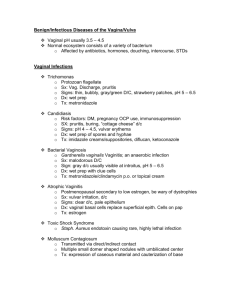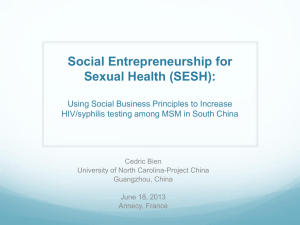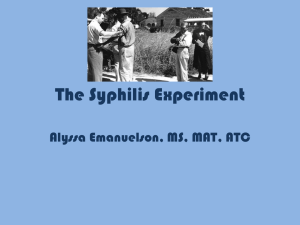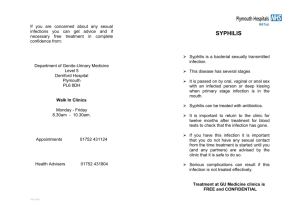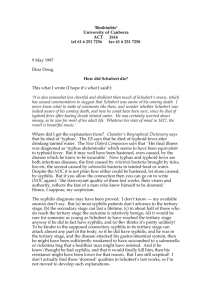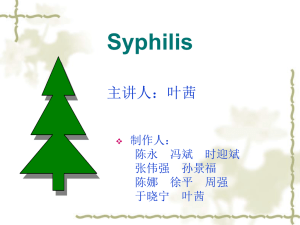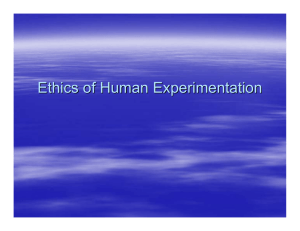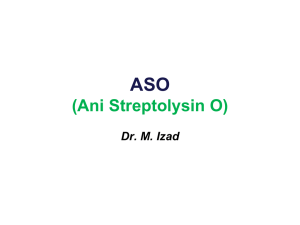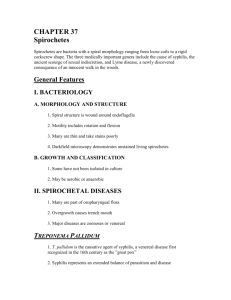Gonorrhea
advertisement
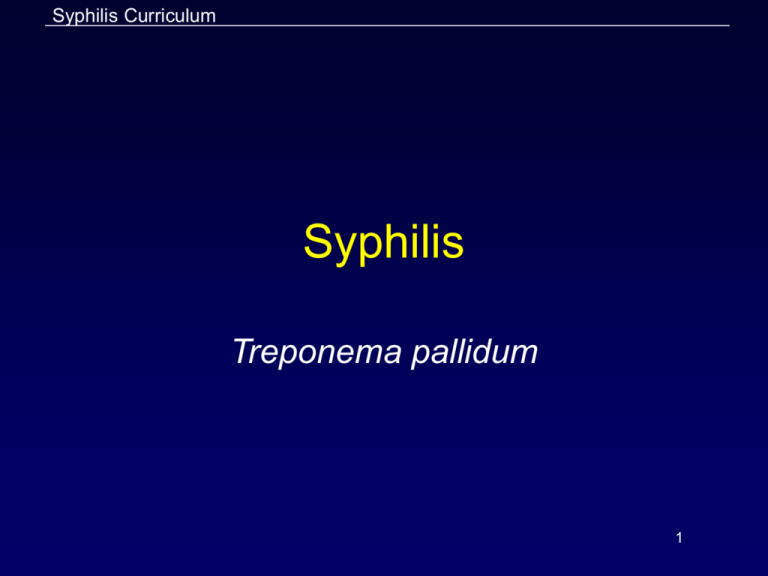
Syphilis Curriculum Syphilis Treponema pallidum 1 Syphilis Curriculum Learning Objectives Upon completion of this content, the learner will be able to: 1. 2. 3. 4. Describe the epidemiology of syphilis in the U.S. Describe the pathogenesis of T. pallidum. Discuss the clinical manifestations of syphilis. Identify common methods used in the diagnosis of syphilis. 5. List the CDC-recommended treatment regimens for syphilis. 6. Summarize appropriate prevention counseling messages for patients with syphilis. 7. Describe public health measures for the prevention of syphilis. 2 Syphilis Curriculum Lessons I. II. III. IV. V. VI. Epidemiology: Disease in the U.S. Pathogenesis Clinical manifestations Diagnosis Patient management Prevention 3 Syphilis Curriculum Lesson I: Epidemiology: Disease in the U.S. 4 Syphilis Curriculum Epidemiology Syphilis Definition • Sexually acquired infection • Etiologic agent: Treponema pallidum • Disease progresses in stages • May become chronic without treatment 5 Syphilis Curriculum Epidemiology Transmission • Sexual and vertical • Most contagious to sex partners during the primary and secondary stages 6 Syphilis Curriculum Epidemiology Disease Trends in the U.S. • Distributed widely throughout the U.S. in the 1940s • Declined rapidly after introduction of penicillin therapy and broad-based public health programs • 1986-90: 85% increase in the incidence of primary and secondary syphilis • During the 1990s, reported cases of syphilis decreased approximately 15% per year to an all-time low in 2000 • Rates remain high in: – Rural areas in the South – Some urban areas throughout the U.S • Recent outbreaks have occurred among subpopulations of men who have sex with men (MSM) 7 Syphilis Curriculum Epidemiology Syphilis — Reported cases by stage of infection: United States, 1941–2003 Cases (in thousands) 600 P&S Early Latent Total Syphilis 480 360 240 120 0 1941 46 51 56 61 66 71 76 81 86 91 96 2001 8 Source: CDC/NCHSTP 2003 STD Surveillance Report Syphilis Curriculum Epidemiology Primary and secondary syphilis — Rates by state: United States and outlying areas, 2003 1.4 0.0 0.6 0.3 1.4 0.9 1.1 0.3 0.3 0.0 3.0 0.4 1.3 0.6 0.6 0.6 3.7 3.0 0.9 3.4 0.9 1.8 3.8 0.8 1.7 0.1 1.1 1.1 0.8 1.9 2.3 1.4 2.5 0.2 1.5 2.1 3.1 0.9 2.0 0.9 5.7 1.8 2.3 Guam 0.6 Rate per 100,000 population 6.8 3.0 4.1 0.2 VT NH MA RI CT NJ DE MD 2.5 3.9 <=0.2 0.21-4.0 >4.0 (n= 5) (n= 44) (n= 4) 1.1 Puerto Rico 5.2 Virgin Is. 2.7 Note: The total rate of primary and secondary syphilis for the United States and outlying areas (Guam, Puerto Rico and Virgin Islands) was 2.5 per 100,000 population. The Healthy People 2010 target is 0.2 case per 100,000 population. Source: CDC/NCHSTP 2003 STD Surveillance Report 9 Syphilis Curriculum Epidemiology Primary and secondary syphilis — Rates by sex: United States, 1981–2003 and the Healthy People 2010 target Rate (per 100,000 population) 25 Male Female 2010 Target 20 15 10 5 0 1981 83 85 87 89 91 93 95 97 99 2001 Note: The Healthy People 2010 target for P&S syphilis is 0.2 case per 100,000 population. 10 Source: CDC/NCHSTP 2003 STD Surveillance Report 03 Syphilis Curriculum Epidemiology Primary and secondary syphilis — Maleto-female rate ratios: United States, 1981–2003 Male-Female rate ratio 10:1 8:1 6:1 4:1 2:1 0 1981 83 85 87 89 91 93 95 97 99 2001 11 Source: CDC/NCHSTP 2003 STD Surveillance Report 03 Syphilis Curriculum Epidemiology Primary and secondary syphilis — Rates by race and ethnicity: United States, 1981–2003 and the Healthy People 2010 target Rate (per 100,000 population) 150 White Black Hispanic Asian/Pac Isl Am Ind/AK Nat 2010 Target 120 90 60 30 0 1981 83 85 87 89 91 93 95 97 99 Note: The Healthy People 2010 target for P&S syphilis is 0.2 case per 100,000 population. Source: CDC/NCHSTP 2003 STD Surveillance Report 2001 12 03 Syphilis Curriculum Epidemiology Congenital syphilis — Reported cases for infants <1 year of age and rates of primary and secondary syphilis among women: U.S., 1970–2003 P&S rate (per 100,000 population) CS cases (in thousands) 20 7.5 Kaufman Criteria 16 6.0 CDC Surveillance Definition 12 8 4.5 3.0 P&S Syphilis 4 1.5 Congenital Syphilis 0 0.0 1970 75 80 85 90 95 2000 Note: The surveillance case definition for congenital syphilis changed in 1988. 13 Source: CDC/NCHSTP 2003 STD Surveillance Report Syphilis Curriculum Lesson II: Pathogenesis 14 Syphilis Curriculum Pathogenesis Microbiology • Etiologic agent: Treponema pallidum, subspecies pallidum – Corkscrew-shaped, motile microaerophilic bacterium – Cannot be cultured in vitro – Cannot be viewed by normal light microscopy 15 Syphilis Curriculum Pathogenesis Treponema pallidum Electron photomicrograph, 36,000 x. Source: CDC/NCHSTP/Division of STD Prevention, STD Clinical Slides 16 Syphilis Curriculum Pathogenesis Treponema pallidum on darkfield microscopy 17 Source: CDC/NCHSTP/Division of STD Prevention, STD Clinical Slides Syphilis Curriculum Pathogenesis Pathology • Penetration: – T. pallidum enters the body via skin and mucous membranes through abrasions during sexual contact – Also transmitted transplacentally • Dissemination: – Travels via the lymphatic system to regional lymph nodes and then throughout the body via the blood stream – Invasion of the CNS can occur during any stage of syphilis 18 Syphilis Curriculum Lesson III: Clinical Manifestations 19 Syphilis Curriculum Clinical Manifestations Primary Syphilis • Primary lesion or "chancre" develops at the site of inoculation • Chancre: – – – – – Progresses from macule to papule to ulcer Typically painless, indurated, and has a clean base Highly infectious Heals spontaneously within 1 to 6 weeks 25% present with multiple lesions • Regional lymphadenopathy: classically rubbery, painless, bilateral • Serologic tests for syphilis may not be positive during early primary syphilis 20 Syphilis Curriculum Clinical Manifestations Primary Syphilis- Penile Chancre 21 Source: CDC/ NCHSTP/ Division of STD Prevention, STD Clinical Slides Syphilis Curriculum Clinical Manifestations Primary Syphilis – Labial Chancre 22 Source: CDC/ NCHSTP/ Division of STD Prevention, STD Clinical Slides Syphilis Curriculum Clinical Manifestations Primary Syphilis – Perianal Chancre 23 Source: CDC/ NCHSTP/ Division of STD Prevention, STD Clinical Slides Syphilis Curriculum Clinical Manifestations Syphilis Lesion - Tongue 24 Source: CDC/ NCHSTP/ Division of STD Prevention /STD Clinical Slides Syphilis Curriculum Clinical Manifestations Secondary Syphilis • Secondary lesions occur 3 to 6 weeks after the primary chancre appears; may persist for weeks to months • Primary and secondary stages may overlap • Mucocutaneous lesions most common • Manifestations: – – – – – – Rash (75%-100%) Lymphadenopathy (50%-86%) Malaise Mucous patches (6%-30%) Condylomata lata (10%-20%) Alopecia (5%) • Serologic tests are usually highest in titer during this stage 25 Syphilis Curriculum Clinical Manifestations Secondary Syphilis Papulosquamous Rash 26 Source: CDC/ NCHSTP/ Division of STD Prevention, STD Clinical Slides Syphilis Curriculum Clinical Manifestations Secondary Syphilis: Palmar/Plantar Rash Source: Seattle STD/HIV Prevention Training Center at the University of Washington, UW HSCER Slide Bank Source: CDC/NCHSTP/Division of STD Prevention, STD Clinical Slides 27 Syphilis Curriculum Clinical Manifestations Secondary Syphilis: Generalized Body Rash Source: Cincinnati STD/HIV Prevention Training Center Source: CDC/NCHSTP/Division of STD Prevention, STD Clinical Slides 28 Syphilis Curriculum Clinical Manifestations Secondary Syphilis – Papulo-pustular Rash 29 Source: CDC/ NCHSTP/ Division of STD Prevention, STD Clinical Slides Syphilis Curriculum Clinical Manifestations Secondary Syphilis Condylomata lata 30 Source: CDC/ NCHSTP/ Division of STD Prevention, STD Clinical Slides Syphilis Curriculum Clinical Manifestations Secondary Syphilis – Nickel/Dime Lesions 31 Source: CDC/ NCHSTP/ Division of STD Prevention, STD Clinical Slides Syphilis Curriculum Clinical Manifestations Secondary Syphilis - Alopecia 32 Source: CDC/ NCHSTP/ Division of STD Prevention, STD Clinical Slides Syphilis Curriculum Clinical Manifestations Latent Syphilis • Host suppresses the infection enough so that no lesions are clinically apparent • Only evidence is positive serologic test for syphilis • May occur between primary and secondary stages, between secondary relapses, and after secondary stage • Categories: – Early latent: <1 year duration – Late latent: 1 year duration 33 Syphilis Curriculum Clinical Manifestations Neurosyphilis • Occurs when T. pallidum invades the CNS • May occur at any stage of syphilis • Can be asymptomatic • Early neurosyphilis occurs a few months to a few years after infection – Clinical manifestations include acute syphilitic meningitis, meningovascular syphilis, ocular involvement • Late neurosyphilis occurs decades after infection and is rarely seen – Clinical manifestations include general paresis, tabes dorsalis, ocular involvement 34 Syphilis Curriculum Clinical Manifestations Neurosyphilis - Spirochetes in Neural Tissue Silver stain, 950x 35 Source: CDC/ NCHSTP/ Division of STD Prevention, STD Clinical Slides Syphilis Curriculum Clinical Manifestations Tertiary (Late) Syphilis • Approximately 30% of untreated patients progress to the tertiary stage within 1 to 20 years • Rare because of the widespread availability and use of antibiotics • Manifestations – Gummatous lesions – Cardiovascular syphilis 36 Syphilis Curriculum Clinical Manifestations Late Syphilis - Serpiginous Gummata of Forearm 37 Source: CDC/ NCHSTP/ Division of STD Prevention, STD Clinical Slides Syphilis Curriculum Clinical Manifestations Late Syphilis - Ulcerating Gumma 38 Source: CDC/ NCHSTP/ Division of STD Prevention, STD Clinical Slides Syphilis Curriculum Clinical Manifestations Late Syphilis--Cardiovascular 39 Source: CDC/ NCHSTP/ Division of STD Prevention, STD Clinical Slides Syphilis Curriculum Clinical Manifestations Congenital Syphilis • Occurs when T. pallidum is transmitted from a pregnant woman with syphilis to her fetus May lead to stillbirth, neonatal death, and infant disorders such as deafness, neurologic impairment, and bone deformities Transmission to the fetus in pregnancy can occur during any stage of syphilis; risk is much higher during primary and secondary syphilis Fetal infection can occur during any trimester of pregnancy Wide spectrum of severity exists; only severe cases are clinically apparent at birth • • • • – – Early lesions (most common): Infants <2 years old; usually inflammatory Late lesions: Children >2 years old; tend to be immunologic and destructive 40 Syphilis Curriculum Clinical Manifestations Congenital Syphilis - Mucous Patches 41 Source: CDC/ NCHSTP/ Division of STD Prevention, STD Clinical Slides Syphilis Curriculum Clinical Manifestations Congenital Syphilis Hutchinson’s Teeth 42 Source: CDC/ NCHSTP/ Division of STD Prevention, STD Clinical Slides Syphilis Curriculum Clinical Manifestations Congenital Syphilis Perforation of Palate 43 Source: CDC/ NCHSTP/ Division of STD Prevention, STD Clinical Slides Syphilis Curriculum Lesson IV: Syphilis Diagnosis 44 Syphilis Curriculum Diagnosis Aspects of Syphilis Diagnosis 1. Clinical history 2. Physical examination 3. Laboratory diagnosis 45 Syphilis Curriculum Diagnosis Clinical History Assess: • History of syphilis • Known contact to an early case of syphilis • Typical signs or symptoms of syphilis in the past 12 months • Most recent serologic test for syphilis 46 Syphilis Curriculum Diagnosis Physical Examination • • • • • • Oral cavity Lymph nodes Skin of torso Palms and soles Genitalia and perianal area Neurologic examination 47 Syphilis Curriculum Diagnosis Laboratory Diagnosis • Identification of Treponema pallidum in lesions – Darkfield microscopy – Direct fluorescent antibody - T. pallidum (DFA-TP) • Serologic tests – Nontreponemal tests – Treponemal tests 48 Syphilis Curriculum Diagnosis Darkfield Microscopy • What to look for: – T. pallidum morphology and motility • Advantage: – Definitive immediate diagnosis • Disadvantages: – Requires specialized equipment and an experienced microscopist – Possible confusion with other pathogenic and nonpathogenic spirochetes – Must be performed immediately – Generally not recommended on oral lesions – Possibility of false-negatives 49 Syphilis Curriculum Diagnosis Direct Fluorescent Antibody-T. pallidum (DFA-TP) • Identifies T. pallidum in direct lesion smear by immunofluorescence • Advantages: – Commercially available – Compares favorably with darkfield microscopy • Disadvantages: – Turnaround time 1-2 days 50 Syphilis Curriculum Diagnosis Serologic Tests for Syphilis • Two types – Treponemal (qualitative) – Nontreponemal (qualitative and quantitative) • The use of only one type of serologic test is insufficient for diagnosis. 51 Syphilis Curriculum Diagnosis Nontreponemal Serologic Tests • Principles – Measure antibody directed against a cardiolipinlecithin-cholesterol antigen – Not specific for T. pallidum – Titers usually correlate with disease activity and results are reported quantitatively – May be reactive for life • Nontreponemal tests include VDRL, RPR, TRUST, USR 52 Syphilis Curriculum Diagnosis Nontreponemal Serologic Tests (continued) Advantages: • Rapid and inexpensive • Easy to perform and can be done in clinic or office • Quantitative • Used to follow response to therapy • Can be used to evaluate possible reinfection Disadvantages: • May be insensitive in certain stages • False-positive reactions may occur • Prozone effect may cause a false-negative reaction (rare) 53 Syphilis Curriculum Diagnosis Treponemal Serologic Tests • Principles – Measure antibody directed against T. pallidum antigens – Qualitative – Usually reactive for life • Treponemal tests include TP-PA, FTA-ABS, EIA 54 Syphilis Curriculum Diagnosis Sensitivity of Serological Tests in Untreated Syphilis Stage of Disease (Percent Positive [Range]) Test Primary Secondary Latent Tertiary VDRL 78 (74-87) 100 95 (88-100) 71 (37-94) RPR 86 (77-99) 100 98 (95-100) 73 FTA-ABS* 84 (70-100) 100 100 96 Treponemal Agglutination* 76 (69-90) 100 97 (97-100) 94 93 100 100 EIA *FTA-ABS and TP-PA are generally considered equally sensitive in the primary stage of disease. 55 Syphilis Curriculum Diagnosis Causes of False-Positive Reactions in Serologic Tests for Syphilis Disease RPR/VDRL Age Autoimmune Diseases FTA-ABS Yes Yes Cardiovascular Disease Yes Yes Yes -- Dermatologic Diseases Yes Yes Drug Abuse Yes Yes Febrile Illness Yes Glucosamine/chondroitin sulfate Leprosy TP-PA Possibly Yes Lyme disease No -- Yes Malaria Yes No Pinta, Yaws Yes Yes Yes Pregnancy Yes* Recent Immunizations Yes -- -- STD other than Syphilis Yes *May cause increase in titer in women previously successfully treated for syphilis 56 Source: Syphilis Reference Guide, CDC/National Center for Infectious Diseases, 2002 Syphilis Curriculum Diagnosis Diagnosis of Latent Syphilis • Criteria for early latent syphilis: – Documented seroconversion or 4-fold increase in comparison with a serologic titer obtained within the year preceding the evaluation – Unequivocal symptoms of primary or secondary syphilis reported by patient in past 12 months – Contact to an infectious case of syphilis – Only possible exposure occurred within past 12 months • Patients with latent syphilis of unknown duration should be managed clinically as if they have late latent syphilis. 57 Syphilis Curriculum Diagnosis CNS Disease Diagnostic Issues • • CNS disease can occur during any stage of syphilis. Conventional therapy is effective for the vast majority of immuno-competent patients with asymptomatic CNS involvement in primary and secondary syphilis. 58 Syphilis Curriculum Diagnosis Indications for CSF Examination • Patients with syphilis who demonstrate any of the following criteria should have a prompt CSF evaluation: – Neurologic or ophthalmic signs or symptoms, – Evidence of active tertiary syphilis (e.g., aortitis, gumma, and iritis), – Treatment failure, or – HIV infection with late latent syphilis or syphilis of unknown duration. 59 Syphilis Curriculum Diagnosis Diagnosis of CNS Disease No test can be used alone to diagnose neurosyphilis. • VDRL-CSF: highly specific but insensitive • Diagnosis usually depends on the following factors: – – – Reactive serologic test results, Abnormalities of CSF cell count or protein, or A reactive VDRL-CSF with or without clinical manifestations. • CSF leukocyte count usually is elevated (>5 WBCs/mm3) in patients with neurosyphilis. • The VDRL-CSF is the standard serologic test for CSF, and when reactive in the absence of contamination of the CSF with blood, it is considered diagnostic of neurosyphilis. 60 Syphilis Curriculum Diagnosis Effect of HIV Infection on Syphilis • Syphilis and HIV infections commonly coexist. • Clinical course is similar to non-HIV-infected patients. • Serological tests for syphilis are usually equivalent in sensitivity in HIV-infected and non-infected persons. • Conventional therapy is usually effective. • Some investigators feel that HIV-infected patients may be more likely to present with symptomatic neurosyphilis. 61 Syphilis Curriculum Lesson V: Patient Management 62 Syphilis Curriculum Management Therapy for Primary, Secondary, and Early Latent Syphilis • Benzathine penicillin G 2.4 million units IM in a single dose • If penicillin allergic: – Doxycycline 100 mg orally twice daily for 14 days, or – Tetracycline 500 mg orally 4 times daily for 14 days Source: Centers for Disease Control and Prevention. Sexually transmitted diseases 63 treatment guidelines 2002. MMWR 2002;51 (No. RR-6). Syphilis Curriculum Management Therapy for Late Latent Syphilis or Latent Syphilis of Unknown Duration • Benzathine penicillin G 7.2 million units total, administered as 3 doses of 2.4 million units IM each at 1-week intervals • If penicillin allergic: – Doxycycline 100 mg orally twice daily for 28 days OR – Tetracycline 500 mg orally 4 times daily for 28 days Source: Centers for Disease Control and Prevention. Sexually transmitted diseases 64 treatment guidelines 2002. MMWR 2002;51 (No. RR-6). Syphilis Curriculum Management Therapy for Tertiary Syphilis without Neurologic Involvement • Benzathine penicillin G 7.2 million units total, administered as 3 doses of 2.4 million units IM each at 1-week intervals • Penicillin allergic: – Doxycycline 100 mg orally twice daily for 28 days OR – Tetracycline 500 mg orally 4 times daily for 28 days Source: Centers for Disease Control and Prevention. Sexually transmitted diseases 65 treatment guidelines 2002. MMWR 2002;51 (No. RR-6). Syphilis Curriculum Management Therapy for Neurosyphilis • Aqueous crystalline penicillin G 18-24 million units per day, administered as 3-4 million units IV every 4 hours or continuous infusion for 10-14 days IV • Alternative regimen (if compliance can be ensured): – Procaine penicillin 2.4 million units IM once daily PLUS Probenecid 500 mg orally 4 times a day, both for 10-14 days Source: Centers for Disease Control and Prevention. Sexually transmitted diseases 66 treatment guidelines 2002. MMWR 2002;51 (No. RR-6). Syphilis Curriculum Management Therapy for Syphilis in Pregnancy • Treat with penicillin according to stage of infection. • Erythromycin is no longer an acceptable alternative drug in penicillin-allergic patients. • Patients who are skin-test-reactive to penicillin should be desensitized in the hospital and treated with penicillin. Source: Centers for Disease Control and Prevention. Sexually transmitted diseases 67 treatment guidelines 2002. MMWR 2002;51 (No. RR-6). Syphilis Curriculum Management Jarisch-Herxheimer Reaction • Self-limited reaction to anti-treponemal therapy – Fever, malaise, nausea/vomiting; may be associated with chills and exacerbation of secondary rash • Occurs within 24 hours after therapy • Not an allergic reaction to penicillin • More frequent after treatment with penicillin and treatment of early syphilis • Pregnant women should be informed of this possible reaction, that it may precipitate early labor, and to call obstetrician if problems develop 68 Syphilis Curriculum Management Syphilis and HIV/Other STDs • Penicillin-allergic patients with syphilis and HIV whose compliance cannot be ensured should be desensitized and treated with penicillin. • All patients who have syphilis should be tested for HIV infection. • Consider screening persons with syphilis for other STDs based on risk. 69 Syphilis Curriculum Management Follow-Up • Primary or secondary syphilis – Re-examine at 6 and 12 months – Follow-up titers should be compared to the maximum or baseline nontreponemal titer obtained on day of treatment. • Latent syphilis – Re-examine at 6, 12, 18, and 24 months • HIV-infected patients – 3, 6, 9, and 12 months for primary or secondary syphilis – 6, 12, 18, and 24 months for latent syphilis • Neurosyphilis – Serologic testing as above – Repeat CSF examination at 6-month intervals until normal 70 Syphilis Curriculum Management Treatment Failure • Indications of probable treatment failure or reinfection include: – Persistent or recurring clinical signs or symptoms – Sustained 4-fold increase in titer – Titer fails to show a 4-fold decrease within 6 months • Retreat and re-evaluate for HIV infection • Some specialists recommend CSF examination 71 Syphilis Curriculum Lesson VI: Prevention 72 Syphilis Curriculum Prevention Patient Counseling and Education • • • • Nature of the disease Transmission Treatment and follow up Risk reduction 73 Syphilis Curriculum Prevention Management of Sex Partners • For sex partners of patients with syphilis in any stage: – Draw syphilis serology – Perform physical exam • For sex partners of patients with primary, secondary, or early latent syphilis – Treat presumptively as for early syphilis at the time of examination, unless: • The nontreponemal test result is known and negative AND • The last sexual contact with the patient is > 90 days prior to examination. 74 Syphilis Curriculum Prevention Screening Recommendations • Screen pregnant women at least at first prenatal visit. – In high prevalence communities or patients at risk: • Test twice during the third trimester, at 28 weeks and at delivery, in addition to routine early screening. – Any woman who delivers a stillborn infant after 20 weeks gestation should be tested for syphilis. • Screen other populations based on local prevalence and the patient’s risk behaviors. 75 Syphilis Curriculum Prevention Reporting • • Laws and regulations in all states require that persons diagnosed with syphilis are reported to public health authorities by clinicians, labs, or both. The follow-up of patients with early syphilis is a public health priority. 76 Syphilis Curriculum Case Study 77 Syphilis Curriculum Case Study History • Stan Carter is a 19-year-old male who presents to the STD clinic • Chief complaint: penile lesion x 1 week • Last sexual exposure was 3 weeks prior, without a condom • No history of recent travel • Predominantly female partners (3 in the last 6 months), and occasional male partners (2 in the past year) • Last HIV antibody test (2 months prior) was negative 78 Syphilis Curriculum Case Study Physical Exam • No oral, perianal, or extra-genital lesions • Genital exam: Lesion on the ventral side near/at the frenulum. Lesion is red, indurated, cleanbased, and non-tender. • Two enlarged tender right inguinal nodes, 1.5 cm x 1 cm • Scrotal contents without masses or tenderness • No urethral discharge • No rashes on torso, palms, or soles. No alopecia. Neurologic exam WNL. 79 Syphilis Curriculum Case Study Questions 1. What are the possible etiologic agents that should be considered in the differential diagnosis? 2. What is the most likely diagnosis? 3. Which laboratory tests would be appropriate to order or perform? 80 Syphilis Curriculum Case Study Stat Lab Results The results of stat laboratory tests showed the following: RPR: Nonreactive Darkfield examination of penile lesion: Positive for T. pallidum 4.What is the diagnosis? 5.What is the appropriate treatment? 81 Syphilis Curriculum Case Study Reference Lab Results RPR: Nonreactive FTA-ABS: Reactive HSV culture: Negative Gonorrhea culture: Negative Chlamydia DNA-probe: Negative HIV antibody test: Negative 6. Do the reference laboratory results change the diagnosis? 7. Who is responsible for reporting this case to the local health department? 82 Syphilis Curriculum Case Study Stan’s Sex Partners Tracy – last sexual exposure 3 weeks ago Danielle – last sexual exposure 6 weeks ago Jonathan – last sexual exposure 1 month ago Tony – last sexual exposure 8 months ago Carrie – last sexual exposure 6 months ago 8. Which of Stan’s partners should be evaluated and treated prophylactically, even if their test results are negative? 83 Syphilis Curriculum Case Study Sex Partner Follow-Up Stan’s partner, Tracy, is found to be infected and is diagnosed with primary syphilis. She is also in her second trimester of pregnancy and is allergic to penicillin. 9. What is the appropriate treatment for Tracy? 84 Syphilis Curriculum Case Study Follow-Up Stan returned to the clinic for a follow-up exam 1 week later. Results were as follows: •His penile lesion was almost completely healed. •He had not experienced a Jarisch-Herxheimer reaction. •The RPR (repeated at the follow-up visit because the initial one was negative) was 1:2. 10. What type of follow-up evaluation will Stan need? 85
